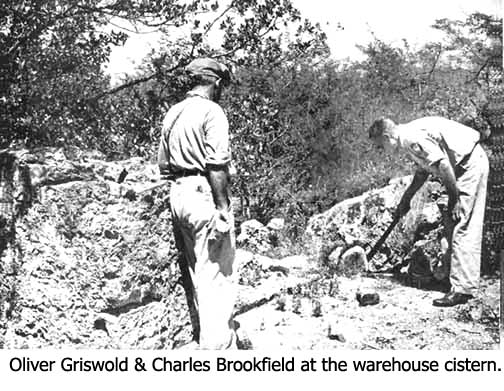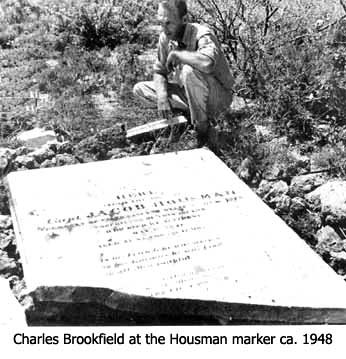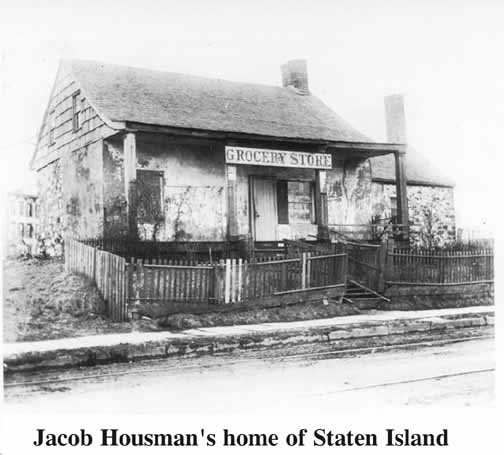General History of Indian Key -
Biography of Jacob Housman
By Jerry Wilkinson
Much has been written about John Jacob Housman and there appear to be many contradictions when studied thoroughly. The following is not intended to be a complete history of Housman and is fragmentary, but contains some of the facts available through genuine research. Much of the data on Jacob Housman from 1830 to 1840 is covered in the web page General History of Indian Key with additional information here.
Jacob Housman was the son of Abraham P., and Mary Mersereau Housman of Staten Island, New York. He had brothers Abraham and George and sisters Lania, Nancy Ann, Elizabeth, Mary, Matilda and Caroline. The Housman family were of Dutch origin (Huysman) and Abraham was probably an oyster man which was the primary industry of Staten Island in the 1800's.
The author believes that much of the legend of Housman's beginnings began with a Pensacola Gazette article, four and a half years after the Indian Key raid, and the opinion of E. Z. C. Judson written on March 29, 1845, "Indian Key was settled in about 1830 by Captain Housman, who commenced business on his own account in the following manner. He was entrusted with the command of a small schooner at an early age, by his father, who owned the vessel. She was employed in the coasting and packet business along the shores of Staten and Long Islands, also up the North River. The young captain, however, was too much of a sailor to keep fresh water, and one day took it into his head to make a 'West Indie' trip without asking his father's permission, making said experiment in his father's vessel. The young captain never reached his destination, for running off his course he struck the Florida Reef. This injured his little craft so much that he was obliged to put into Key West for repairs, during which time he got such an insight into the 'wrecking' business that he concluded to became a wrecker himself. . . ,"
To read the entire article and it is lengthy Click HERE.
Supposedly the ship that Housman took was the WILLIAM HENRY. According to data from the National Archives, the WILLIAM HENRY's certificate of enrollment was issued at Charleston, S.C. on July 1825 and the certificate of Registry at St. Augustine, Florida on December 6, 1825. The previous managing owner was William Barker. She was a two masted schooner, 46 and 76/95 tons, 56 feet in length, 19 feet in breadth, 6 feet depth and built in 1821 at Havershaw, New York. Jacob Housman was shown as the sole owner from January 24, 1825 to April 9, 1827 when the vessel was lost. For your information, a certificate of enrollment restricts a vessel to coastwise trade only whereas that of registry permits either foreign or coastwise trade. To date, I have been unable to prove that his father, Abraham, ever owned the WILLIAM HENRY.
The National Archives also stated that it could locate no reference of charges of Jacob stealing his father's boat in the early 1820's. This alone does not mean that it did not occur, or it was some other ship. This would be an interesting summer project for someone living in the New York area to research the names of ships that Abraham P. Housman owned in the early 1820's. The Charleston Courier on July 27, 1822 shows the port departure under the charge of a Captain Housman, a sloop, the WILLIAM HENRY. The purpose, or destination was not indicated.
We know that Housman was in the Keys in 1825 via the records of the adjudication of the cargo of the French brig REVENGE in Key West.
National Archives Records also record ownership by Jacob Housman in the ships BRILLANT, FAIR AMERICAN, JOHN DENISON, KEY WEST, MARTHA JANE, MOBILE, SARAH ISABELLA, SYLPH, THISTLE and UNITED STATES. It is interesting to note from these records that Jacob sold the SARAH ISABELLA to his father Abraham Housman - September 25, 1828, who sold it to his son George on February 5, 1830, who sold it back to Jacob's brother, George, on March 7, 1831.
Now to the property of Indian Key, Monroe County Deed Record books indicate that Silas Fletcher sold to Thomas Gibson all his right, title and interest to Indian Key on November 13, 1828 for $2500. Richmond County, N. Y. Records of Deeds also show that Abraham purchased property from a Silas Fletcher on December 28, 1830 in New York. Congress later declared that neither Silas Fletcher, Jacob Housman nor anyone else owned Indian Key in the 1800s. However, Indian Key property was sold back and forth until finally in 1908 the U.S. Government issued a legal land patent deed to W.W. Dewhurst for $68. Some other significant recorded transactions are as follows:
The first recorded Indian Key property sold to Jacob Housman was on November 19, 1830 for $30 and was the property of William Johnson consisting of a one story building with two rooms and a kitchen.
Thomas and Ann Gibson in turn sold to Jacob Housman a two-story house, a store, 9-pin alley, billiard room and table, outhouse and kitchen for $5,000 on July 5, 1831. One might conclude that Housman was serious about Indian Key around this time, if not before.
Jacob and Ann Housman sold to Charles Howe a lot and house for $580 each on April 23, 1835.
Joseph Prince sold to Jacob Housman all his rights and titles to Indian Key including all buildings and improvements for $5,000 on November 3, 1835.
Much is written about Housman's adjudicated misdeeds as a wrecker. However, it must be remembered that it was a rough-and-tumble occupation in which to be involved. In reviewing the Admiralty court records, there were many cases found in his favor. His large participation in the industry, as well as the nature of the industry, would have necessitated considerable court action. It can be argued that there may have been many irregularities that were never reported and that he was worse than the records indicate. Who knows?
There is little doubt that Housman was the political and economic force for the development of the small island. Had the island been larger and a source of at least brackish water it would have been a force to be reckoned with. One must remember that both it and Key West were developing almost together, Key West having a slight head start, size, military, deep water port, etc. As small as Indian Key is, had Housman been able to maintain his on-site militia and prevented the massacre, history could have been significantly different.
Jacob Housman mortgaged Indian Key and buildings thereon (except those belonging to Charles Howe) to Smith Mowry, Jr. of Charleston, S.C. for $8,583 on March 19,1840. On the same date Jacob mortgaged the same property to Joseph Lawton of Charleston for $5,726.62 at 10% interest. This was about four and a half months before the August 7, 1840 attack. It is also three days after Housman's proposition was presented by a Mr. Dowling "...to the Governor and Legislative Council of Florida and to the President and national Congress of the United States, to catch or kill all the Indians of South Florida, for $200 each."
One can wonder what he had done with his mini fortune in those days and why the mortgages were necessary. It does appear that he had lost his fortunes in the latter days of his life. Read on.
After the attack, Jacob and Ann sailed to Key West and eventually auctioned off some of his remaining property. In early May 1841, while at sea he died.
Six days later, Jacob G. Pierce filed for damages in Key West for the collision of Housman's ship KEY WEST with the LEANDER on April 30, 1841 which was the day before his death. On May 30, 1841 with Mrs. Housman as the respondent, Judge Marvin found in favor of Pierce ordering, " ..recover of the said sloop KEY WEST, her tackle, apparel and furniture or their owners the sum of $65 for the damages sustained by the Brig LEANDER ...as well as his costs and charges in their behalf expended..." The collision occurred the day before Housman fell to his death. Was there a connection? Not much is written about Housman's activities while in Key West.
One reference that I found of Mr. Housman being interred on Indian Key was that by Henry Perrine Jr. in his "Return Visit to Indian Key In 1876." He wrote, "Near Housman's epitaph stood the charred trunk or stump of a palm tree . . . ." Nothing of the nature of the epitaph was revealed by Henry Jr.
Another reference is by J. B. Holder in his writing of Along the Florida Reef during his voyage of 1860: ". . . Near by was an ambitious looking slab, covering a brick tomb. . . . " This is the only reference I have found of it being a brick tomb.
A newspaperman in the Florida Times Union on May 22, 1892 wrote the following: "...Any one who visits Indian Key will see upon the beach a ponderous slab of the purest marble; its size is about four feet wide by seven feet in length; it lies on the beach - it "lieth" in more ways than one, for it is a standing falsehood. The inscription is something like this: (he quotes). The stone does not tell the truth, because the body of Captain Houseman [sic] does not lie beneath; in fact the stone remains on the beach where it was landed, just above the high water mark, years and years ago..."
This was 51 years after Housman's demise and a lot of activity had taken place on Indian Key during that time. The great hurricane of 1846 washed away the Key West graveyard so there is no way to ascertain if there was a burial plot there. Anyway, the broken marble epitaph was taken to Miami by the Historical Association of South Florida in 1952 and now is at Lignum Vitae Key.
There was another unresolved court case at the death of Mr. Housman. This involved the case of Housman versus Cussans, November 19, 1839, Docket 64 of Superior Court. Housman sued for costs, " •.. of supplies, repairs and other necessities to be able to sail upon the high seas..." in a contract with Richard W. Cussans for the sloops CITIZEN and VEVILIA. The case was still not settled at his death and Mrs. Housman petitioned to be substituted which was granted. She won, but the settlement was reduced by 10 percent for overpricing, but increased by eight percent for interest owed. Cussans appealed and lost.
Housman left no legal last will and testament and Judge L. W. Smith in Key West on January 20, 1842 revoked Elizabeth Ann Housman claim as the executrix to Jacob's will. The following letter of administration was found in Richmond County, N.Y. 1787 - 1865, file number 448, book 2, page 150, June 29, 1841, May 13, 1843: "Jacob Housman of schooner Sylph at Key West or Indian Key off the Florida Coast. Administrator: Father, Abraham P. Housman. Widow: Eliza Housman at Key West. No children." The only item listed as part of his estate was the schooner SYLPH valued at $1,500.00. One should note that the vessel KEY WEST registration continued in the ownership of Jacob Housman until June 4, 1842. His father, Abraham, pursued the probate action vigorously for years and eventually lost. His primary efforts seemed to be directly at reimbursement for the militia expenses since it became fairly obvious that Jacob did not have title to the land and his buildings that were burned by the Indians.
After the raid and Housman's demise on May 1, 1841, Indian Key, except for the Howe property, was sold at public auction to Mowery and Lawton of Charleston, S.C. for $355 on January 15, 1844.
Mrs. Ann Housman remarried later in 1841. The following data is included in the Monroe County Court House records 11-64, "Crawford Thompson, Esqr. of Sheffield, England and Mrs. Elisabeth Ann Housman of Indian Key, Dade County, at present of Monroe County, Florida were married on December 14, 1841 at Key West by Alfred E. Ford, Minister of the Protestant Episcopal Church."
There is some evidence that Jacob Housman had a home also on Lignum Vitae Key. Henry Perrine Jr. wrote during his "Return to Indian Key in 1876" that while a Captain Bethel was escorting him around: "We did not stay long (on Lower Matecumbe) as the captain wanted me to go over to Lignum Vitae Key, the island where Capt. J. Housman had very extensive improvements, to show me his watermelon patch and pineapples. The only trace of Housman's former occupancy was a portion of the wall and chimney of a kitchen." Rudy Atmus photographed the site in 1964.
There is a lot written about Indian Key and Jacob Housman. Some of it involves the operation of the U. S. Navy in the area. Much of the Housman claim against the U.S. government involves support provided to the Navy from about 1836 up to the raid. Additional claims were for the formation and maintenance of Company B, 10th Florida Militia (included in this web site) for the defense of Indian Key. In Senate Report 484 of the 29th Congress on August 8, 1846 is shown, "The extent of the indemnity claimed is $144,630 . . . ."
Later in House Report 798 - 30th Congress - 1st Session - June 25, 1848 Committee of Claims Report said in part, " . . . What right had Housman to this property? He had no title from Spain previous to the Florida Treaty . . . .we notice a remarkable fact, that some $15,000 or $20,000 of this claim is for the burning of cisterns cut in solid rock of the island . . . Housman had no real right there whatever." This ended the claim of the Housman heirs who received nothing from their pursuit.
A great juvenile novel, now out of print, about Jacob Housman and Indian Key, and fairly factual, is The Rumskudgeon by Kaye Carter available in our local libraries.
Some of this information is repeated in other chapters.
-Continue tour to a list of ships owned by Housman 
Return to Indian Key Home page

